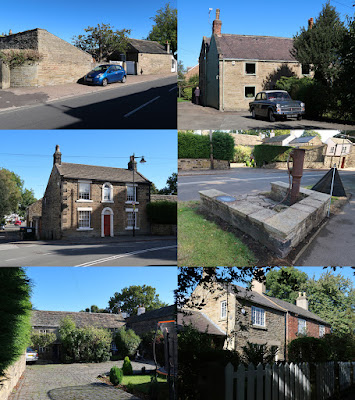 |
| A detail of the Wesleyan Methodist Church on Greenhill Main Road |
A few days after my longest walk of 2021 – about 12 km from Walkley to Hillsborough via Malin Bridge and Wadsley – I set out on another fine day in the first week of October to go and have a look at the Bradway Board School – one of four on my list of Sheffield Board Schools that I wanted to visit before the year was out and bring this project to a conclusion.
Arriving on the No. 25 bus from Sheffield in bright sunshine, once the children had gone inside, I just took a few quick photos of the principal elevations of this very simple school, which was built in 1903 for the Norton School Board to the design of an unknown architect, without examining the stonework. Looking at my photos, however, its general texture and thinly coursed walling is like the Crawshaw Sandstone from Bole Hill, but its blackened surface prevents me from making any firm conclusions as to its provenance.
With very little of architectural interest, except the pediments to the front and rear elevations with their alternating stone and herringbone brickwork – including a carving of the Chantrey Memorial Obelisk on Norton Green – I headed along Bradway Road to photograph The Cottage, before following it further towards Greenhill.
The area is largely dominated by brick built inter-war houses set in spacious gardens, with later post-war developments, but the terrace of houses forming Nos. 46-52 (1769) and the early C19 Bradway Lodge are both built out of local sandstone, with stone tile roofs.
The underlying geology mainly comprises thin bodies of unnamed sandstone, which alternate with mudstones of the Pennine Lower Coal Measures Formation - as well as the Grenoside Sandstone. Although small quarries are marked nearby on the 1883 Ordnance Survey map, the very thin courses and the dark brown iron staining are very characteristic of the Greenmoor Rock. This was quarried extensively at Meadowhead, now the site of Morrisons supermarket, which is less than 2 km away as the crow flies, and has been used for most of the historic vernacular architecture that I have seen in the area.
Continuing along Hemper Lane, which is lined with more inter-war houses, I came to Greenhill Main Road, which is marked on the 1883 map as a substantial village surrounded by open countryside. Although I had a list of ten historic buildings to photograph for the British Listed Buildings website, which should have given me clues what to expect during my exploration of the area, it still came as a great surprise to discover such an attractive place in this sprawling suburb of Sheffield – as had nearby Norton a few years earlier.
Wandering around the Conservation Area, which is centred on Greenhill Main Road and School Road, the oldest of the Grade II Listed buildings is the rendered late C16 The Manor, with several others dating to the C18 and also the C19 village water pump. These provide further examples of the use of Greenmoor Rock, as do miscellaneous boundary walls, with what looks like yellowish Grenoside Sandstone being used to build No. 59 Greenhill Main Road (1829).
Continuing with my walk around the Conservation Area, I noticed that other buildings were built in sandstones that I could not obviously identify as being Greenmoor Rock, with the course heights of the walling being higher than would normally be expected in this typically fine grained and laminated stone; however, I didn’t stop to look closely at any of the building stones that I saw and these need further investigation.
The Wesleyan Methodist Church on Greenhill Main Road, in particular, is built with quite large blocks of a greyish sandstone that hasn’t weathered particularly well and which also doesn’t look very much like the Greenmoor Rock I had seen in the village and, furthermore, the dressings are slightly pinkish in colour.
I haven’t been able to find out much about the Wesleyan Methodist Churches in Sheffield and the architects who designed them but, as seen in Mosborough and Maltby, the sandstones used stand out against the materials used for the vernacular architecture in the village.
Returning to School Lane, I stopped briefly to take a few photographs of the houses and attached workshop at No. 80 Annesley Road, c.1800, before continuing to Greenhill Drive, where I asked the owners if I could photograph Grange Farmhouse and its attached cottage, before making my way down to Woodseats along the A61.











No comments:
Post a Comment